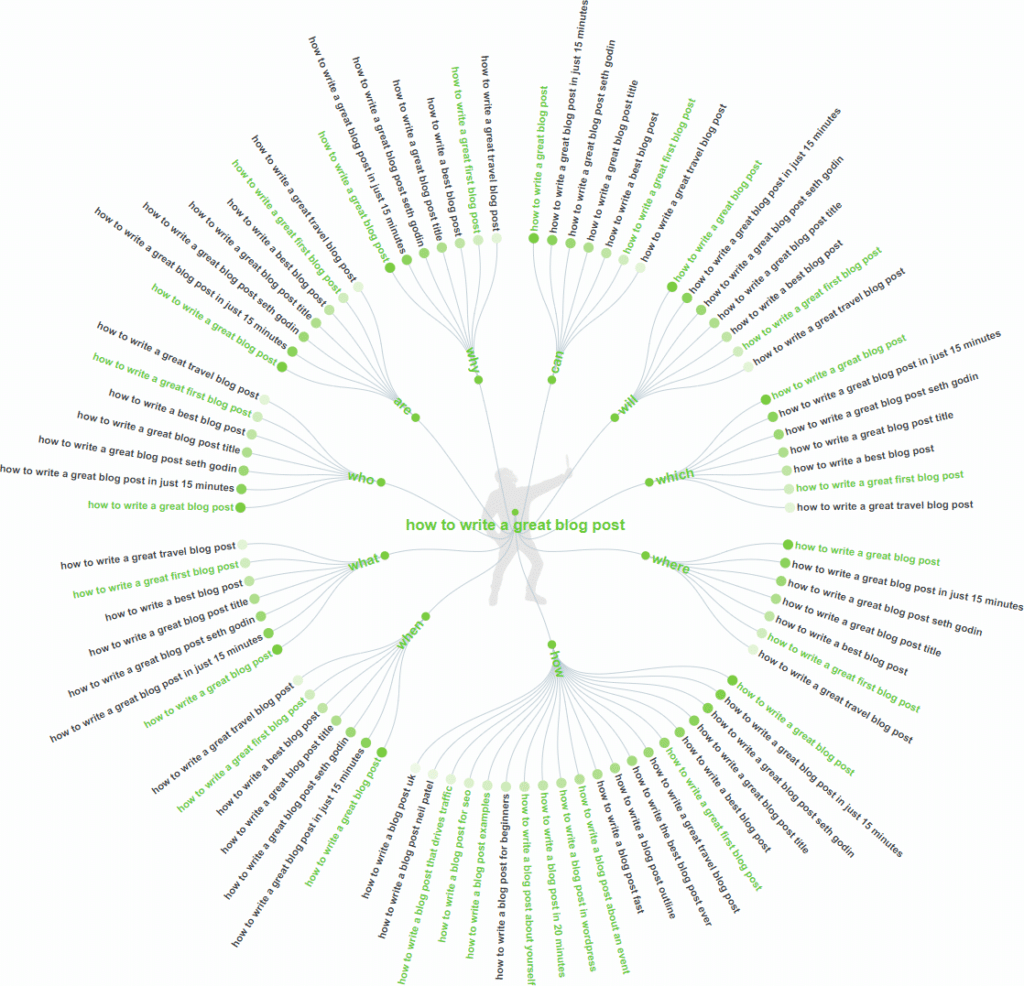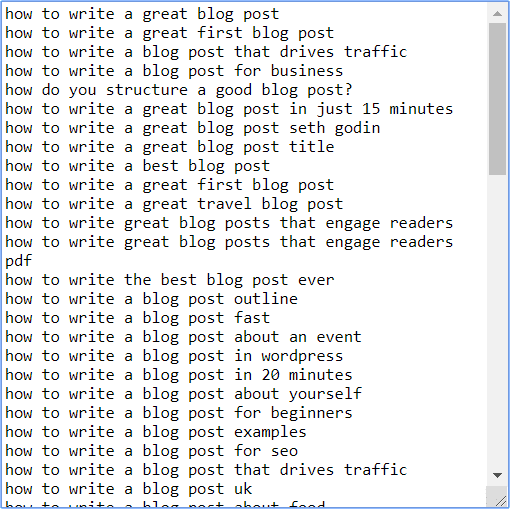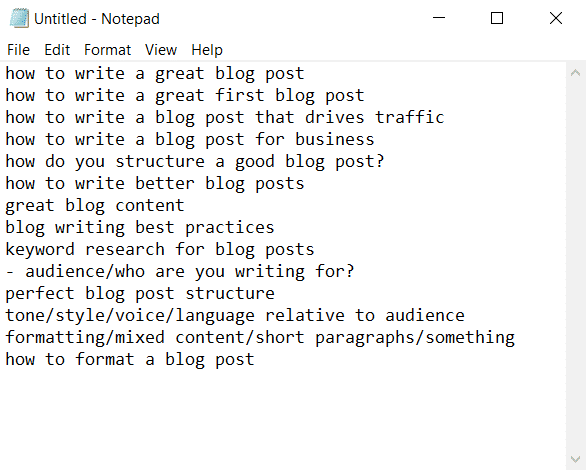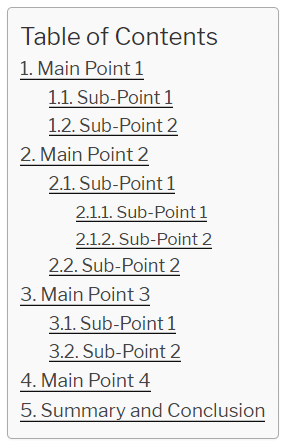Writing a great blog post may come easily to some, but if you are reading this article, chances are you’re like me and you have to work for it.
I started my first blog in 2009, publishing long posts that made no clear points. They were written for no-one in particular, never ranked in Google and as a result nobody ever read them.
A decade of learning, failing, succeeding, and working with others in the content production space has helped me to form the process you’ll see in this post.
Today I can write an article and my desired audience have read it by the time the month is out. I’m not the best writer around, but this process helps me to write content that my readers take the time out of their day to email and thank me for.
This isn’t an article on blogging for SEO, it’s a guide to writing blog posts that people will actually read. When these people do read your post, it will help them. Ironically, search engines love content that do those things.
If you want to know how to write a great blog post, read on to find out my methods.
Research
A common mistake for many writers is to put pen to paper right away.
They will be given a brief (which is often only a topic) and immediately sit down to write their article with energy, but little direction. Even worse, many have no knowledge whatsoever on the topic!
The research phase will help you to write a blog post outline, which can then help you to work with a team of content writers in future.
When you are researching, you need to start from the beginning:
- Who are you writing for?
- What are they actually searching for?
- What language are they using?
Keyword Research for Blog Posts
This is going to sound like the type of thing only an SEO should do, but hear me out.
Keyword research is an incredible process for getting into the mindset of your reader.
There are a lot of free tools on the market to help you with this, but for writing content, my personal favs are:
2022 Update: I mostly defer to Ahrefs these days, as it saves me a lot of time, but it can be expensive for a newcomer.
These all serve different purposes, which we’ll dive into below, but when you use them remember to take notes.
If you need help with bulk keyword research it’s something I do over at Dialed Labs. I have custom tools built to create content plans for many articles at once.
By the time you’ve completed your research, you’ll be half way to having the structure of your finished post.
Answer the Public
This is an awesome tool for drilling down into the questions that your readers are actually asking.
I personally find the “questions” and “prepositions” features of this tool the most useful, but there are some gems in the other features.
By using Answer the Public, I can see that people are searching for other, more specific variations:
- how to write a great first blog post
- how to write a blog post that drives traffic
- how to write a blog post for business
There are no tricks here. If you want to write a kickass outline, Google will do half of the work for you.
Search for your topic or keyword, if you’re lucky you’ll see these:
This won’t be available for all searches you do though, so instead you might need to scroll to the bottom of the page where you can see related searches:
Keyword Shitter
Poo jokes aside, Keyword Shitter is so simple it’s amazing. You can enter your topic, or your list of research so far and ask for it to Shit Keywords!
Give it a few minutes and you’ll have a lengthy list of keywords. The only problem with this tool is it gives you too many keywords.
I usually grab the first 2,000 keywords then sort them by search volume to make shortlisting easier.
Who Are You Writing For?
Before you begin writing your post, you really need to consider who will be reading it.
When I was doing my research for this article, I began to see some common themes:
- Some people were searching based on time, where they were looking to get the post written “in 15 minutes” or “fast”.
- Many were referring to a “first blog post” or “for beginners”.
- Others were very specific in that they were writing “for search engines”, to “drive traffic” or to “engage readers”.
There are more segments, but from the 3 points above it’s clear there are 3 different types of people searching in this space:
- “Professional” writers who are probably being paid per article or per word. These people want to write articles quickly but aren’t necessarily looking to produce quality.
- Beginners and first-time writers, who may either be writing for their own blog or they could be an intern in a marketing department looking to make a good impression.
- A marketer with a very clear business goal in mind – driving traffic to their website, and keeping readers on their website once they get there.
In the context of what I’m writing here, the title is How to Write a Great Blog Post. This title implies that you don’t want to produce bad content. You don’t even want to produce good content. You want to produce great content -probably the best!
This means you’re probably an independent blogger writing for your own site, a freelancer writing professionally for 3rd party websites, a marketing team member or manager who writes on behalf of your business, or a professional writer who blogs on a daily basis for your employer.
Keyword Intent: What Do Your Readers Want to Learn?
This topic is complex, but I’ll keep this section simple.
Above we looked at the different segments of people reading your article and we already drilled into what they want to achieve.
From here, your job is to get inside their head and consider what they want to learn from your article. If you do this job well, they’ll read it from beginning to end. If you don’t, they’ll bounce away from your post immediately.
- Those who want to write quickly are going to be looking for tactics on researching quickly, structuring articles quickly, and typing (or possibly using text-to speech tools) quickly. If this is your audience, your task is to give them ways to be more efficient in what they are doing.
- Beginners and first-timers who are new to blogging. They don’t need to write quickly, nor do they explicitly want to improve SEO. Instead, they are best served by understanding the fundamentals of writing something well. Don’t overwhelm them with the “top 54 things you must do”, instead give them the most important. Keep it simple, without skipping anything necessary
- Marketers on the other hand, want to learn how to do content marketing for their business well (that is better than their competition). If you are writing for this segment, you know they won’t waste their time with cheap content written in 15 minutes, and they’re no longer beginners. These guys want to know how to get the number 1 spot in Google, and keep people engaged in their content when they click through.
Again in the context of this article, in the section above I mentioned a few categories that you may fall into. The benefit for me when writing this article is, even if you aren’t in any of these categories, I still know what you want to achieve; you want to learn how to produce great content.
As long as I help you to do this, you will (hopefully) be happy!
Crafting the Perfect Structure
Knowing who you are writing for and what they want to learn is only the beginning. The quest of learning how to write better blog posts continues by perfecting your post’s structure.
By the time my research is done, I’m left with a heap of notes in Notepad. Many of these are keywords, some are thoughts of points I’d like to make.
Half of the work is done here, you just need to arrange everything logically.
This is where the war is won or lost in my opinion. The 5-10 minutes it takes makes every bit of difference to your reader.
I drill into how to structure blog posts in depth here, though below you’ll find the main take aways.
A Kickass Introduction
The first paragraph of your article is the most important. It’s your opportunity to hook the reader in, or to turn them away.
If you want to hook your readers, it needs a strong first paragraph that makes the reader think “yes, this is why I’m here”.
This first paragraph should then lead on to an introduction that backs this up, and gives the reader an insight into what they are going to learn or achieve by spending their precious 5 minutes reading the article.
Go back to the top of this article and read my intro:
- First paragraph: reminds you (the reader) why you’re here.
- Second, third and forth paragraphs: explains why you should listen to me (the writer, brand, company or whomever you are writing on behalf of).
- Fifth paragraph: outlines what this article is about.
- Last paragraph: identifies what you will get from spending your time reading this post.
Without a strong introduction, you’ll struggle to write posts that engage readers.
The Body of Your Content
The main points of your article all need to be clearly arranged into sections. This is most easily visible when using a Table of Contents for your articles.
In this article, I wanted to make 4 main points:
- Do your research
- Structure your post well
- Consider who you are talking to and who you are representing, then speak to them in an appropriate voice
- When relevant, use statistics as these often help to earn links from other websites
- Present the article well
These points become my core headings which are formatted as Heading 2 tags (more on that later). Any sub-topics within these sections can be given a sub-heading.
By doing this, you keep everything organised and on topic. It also allows someone who is already a pro at one thing to skip ahead to something that is more important to them, helping your engagement rate.
Summary and Conclusion
Imagine reading a long article – you’ve spent 15 minutes of your life doing so, and at the end there’s no conclusion. They made their last main point and that’s that.
Isn’t that kind of frustrating?
Your post’s conclusion is an opportunity to summarise the article – bundling up your key points together them all together, giving the reader some sort takeaways and next steps.
Doing so makes you look like an expert in your field. It gets social shares and encourages readers share it with a colleague if it’s relevant.
Your call to action is the next step – once you’ve made your summary and shown the reader you know what you’re talking about, it’s your opportunity to ask for something in return.
Examples of calls to action to use in your conclusion will depend on your goals:
- Travel blogger: “Thinking of visiting the Perhentian Islands? Click here to book your accommodation: [partner link]”
- B2B content marketer: “Interested in how your business can increase revenue by 200%? Sign up to get our free guide: [signup form]”
- Affiliate marketer: “Convinced that the Dogmaster 5000 is the best product for your pup? Click here to buy it on Amazon: [affiliate link]”
- Business coach: “Did these 5 tips help you to become a better manager? Let me know by sending me a tweet [@username]”
Of course, there are many things you can ask someone to do at the end of the article. It may even be to simply read another article of yours, or to leave a comment.
And if you truly don’t want anything – you don’t have to ask for anything. But if you are writing for a purpose, you’d be crazy not to ask.
Even asking for feedback on whether the article was helpful will help you to develop as a writer.
Voice
When reading an article, people read it in a certain voice. Part of this you can’t control, but part of it you can.
I am not an expert writer, so I’m not going to speak with authority here, only what I’ve found. You absolutely must consider:
- who you are writing for, and
- who you are (in the context of the article).
I established who you were earlier. This site is a tricky one in that it represents me professionally just as it does personally. Nowadays, I have come to terms with the fact that I can drop an f-bomb in an email and still sign it off with “best regards” (or “regards” if I’m livid).
As a result, the way I write on this site is what you should expect of me in real life. I try to speak with knowledge and experience, but I’m also fairly casual, despite being professional.
But professionally this can be trickier.
Say you’re ghost writing for a client who sells a software product that helps contractors and tradespeople to get more reviews online.
Come across as a sales executive, and your content won’t connect with the reader. Your content probably needs to be more casual and should use words that your reader is used to using in the work they do.
At the same time, you need to be writing in your client’s voice – in this example, someone who helped to produce a piece of software. You’ll need to keep this in mind while writing.
Generally though, I recommend:
- writing as if you are saying it,
- not trying to sound smart,
- speaking from experience,
- telling stories along the way,
- giving examples,
- referring to “you”, and “your”.
Notice how often I make a suggestion for you to do something in this post? That’s because I’m talking to you.
Formatting Your Content
The final major piece of the puzzle is taking what you have so far and making it easy to read.
2010 is long gone, and let me tell you getting people to read your post is hard nowadays. Getting people to read every word you write is borderline impossible.
Microsoft claims our attention span is now 8 seconds long.
Human brains are fried – most of us can’t concentrate on a task for 5 minutes let alone read an article from beginning to end without a chat notification from a friend interrupting, letting us know about something borderline interesting that is happening to them and not us.
If you want to write a great blog post, you have to take this into account. Even engaged readers will leave your article to make a cup of tea or reply to their boss’ email.
You want to make it easy for them to return to your article. You also want to make it easy for them to speed read and get the general gist of what you’re on about before committing to actually reading the whole thing.
Headings
The good news is, by structuring your article correctly, you’ve done the heavy lifting. Your reader can see the key points you’re making.
Ensure you are using heading tags correctly. The title of your article is a Heading 1. If you’re writing in WordPress, this often already done for you. When the title is well written, it doubles as a great headline that hooks the reader in.
Your main points and conclusion use Heading 2 tags. Anything below that are “nested” in as Heading 3, Heading 4, and so on.
Your article will be very easy to navigate, and as an added bonus, visually impaired readers will thank you for making your post easy to use with a screen reader!
Paragraph Length
Next up, you’ll want to keep your paragraphs short. Remember that 8 second attention span? Short paragraphs are easier to read.
It also means your readers are more likely to read the next paragraph – as that is also short. 1-3 short sentences per paragraph is a good general rule.
Use Lists!
You’ll note in this article that I use numbered and bullet lists regularly. Similar to using short paragraphs, lists are easy to skim over.
They also break up those endless walls of text. When you want to make multiple points at once, use a list!
Break up Your Post with Images or Videos
Ok, I know you are technically here to learn how to write a great blog post, but here’s a bonus round for editors or “all-in” content producers.
Endless walls of text are overwhelming to your readers.
Relevant images or videos are great at splitting up your articles, but they should still be relevant.
Just as each paragraph you write should be relevant to the heading above it, so too should any images or embedded videos. They should help your readers, not confuse them!
How to Write a Killer Blog Post
I’ve talked about a lot here, but writing something great is simpler than it may seem.
Here are your key takeaways:
Research
- Establish who you are writing for.
- Research what they are looking for.
- Pay attention to the language your reader uses when doing your research.
Structure
- Tell your reader what the article is about and what they will learn in your introduction.
- Get your main points across in logical sections.
- Follow up with a summary and call to action.
Voice
- Use similar language to your reader, so you’re relatable.
- Write as if you are saying it.
- Talk to your reader, using “you”, “your”, etc.
Formatting
- Use headings and sub-headings to format your post nicely.
- Keep paragraphs between 2-5 lines.
- Use lists.
- BONUS: Break up text with images or videos.
Simple, right?
How many of these rules did I break while writing this blog post? If you pick up on any, leave a comment below so I can get them fixed!









Really informative article. I am in the ‘maybe want to be a blog writer/content provider but not sure if I have any talent’ category!! So, I usually read lots of how-to articles on the subject.
However, I must say that yours was very succinct and also, easy to read and understand the concepts you presented. And, yes, I read the whole post!
How we found you… my husband and I live in France and therefore, pay A LOT of taxes and he is always looking for a place that doesn’t have so many taxes. He found Andorra and had me do more in-depth research and voilà 🙂
So, just wanted to say GREAT job!!
Thanks,
Keli
Great and amazing article written by Jase. Thanks for sharing this valuable information with us. It will definitely help me in honing my writing skills. it’s a really helpful article!
Excellent article. Very helpful THANK YOU!
I’m glad you found it helpful Catherine!